- Home
- Albums»
- Western Europe»
- England, Sept. 5-7, 2016»
- England/Belgium/Wales, July 5-16, 2005»
- France, May 12-29, 2018»
- Days 1-3, Paris, Mont Saint-Michel
- Day 4, Notre Dame; Marais
- Day 5, Normandy
- Day 6, Rodin Museum; Seine Cruise
- Day 7, Paris: City Tour, Musee d’Orsay & l’Orangerie, Montmartre
- Day 8, Champagne; Dijon
- Day 9, Burgundy, Beaune, Lyon
- Day 10, French Alps, Sisteron, Grasse, Cannes
- Day 11, French Riviera
- Day 12, Avignon, Pont du Gard
- Day 13, Carcassonne; Lourdes
- Day 14, Lourdes, Bordeaux Wine Country, Saint-Emilion
- Day 15, Bordeaux
- Days 16-18, Loire Valley, Cognac, Paris
- France/England/Belgium, Sept. 9-26, 2004(A)»
- France/England/Belgium, Sept. 9-26, 2004(B)»
- Greece/Turkey, Oct. 12-Nov. 5, 2005(A)»
- Greece/Turkey, Oct. 12-Nov. 5, 2005(B)»
- Greece/Turkey, Oct. 12-Nov. 5, 2005(C)»
- Ireland, Sept. 12-28, 2016»
- Italy, April 17-May 8, 2005(A)»
- Italy, April 17-May 8, 2005(B)»
- Italy, April 17-May 8, 2005(C)»
- Italy/Switzerland, Sept. 27-Oct. 8, 2007»
- Northern Ireland, Sept. 8-12, 2016»
- Northern Ireland/Ireland, Sept 8-12, 2016»
- Portugal, March 19-April 5, 2008(A)»
- Portugal, March 19-April 5, 2008(B)»
- Portugal/Spain/France/Andorra, May 29-June 19, 2019»
- Days 1-3, Lisbon
- Day 4, Lisbon
- Day 5, Lisbon, Casais, Cabo da Roca, Sintra
- Day 6, Fatima, Porto
- Day 7: Porto, Portugal, to Santiago de Compostela, Spain
- Day 8, Santiago de Compostela & La Coruna
- Day 9, Luarca, Espana Verde, Oviedo
- Day 10, Santander; Bilbao
- Day 11, San Sebastian; French Basque Country
- Day 12, Pamplona; Zaragoza
- Days 13-15, Barcelona
- Day 16, Barcelona
- Day 17, Girona; Figueres: Salvador Dali Museum
- Days 18-19, Barcelona
- Day 20, Three-Country Tour; Monserrat
- Day 21, Barcelona, Going Home
- Scotland, July 18-23, 2005»
- Spain, Oct. 13-18, 2006(A)»
- Spain, Oct. 13-18, 2006(B)»
- Spain, Oct. 24-25, 2010»
- Canada»
- British Columbia, Feb. 24-28, 2005»
- Maritimes, Oct. 5-15, 2015, 2015»
- Days 1&2: Lunenburg/Mahone Bay, Nova Scotia
- Day 3: Nova Scotia to Prince Edward Island
- Day 4: Prince Edward Island
- Day 5: Prince Edward Island to Cape Breton, Nova Scotia
- Day 6: Cabot Trail, Nova Scotia
- Day 7: Cheticamp to Baddeck, Nova Scotia
- Day 8: Louisbourg Fortress & Baddeck, Nova Scotia
- Day 9: Peggy’s Cove & Titanic Graves, Nova Scotia
- Days 10 & 11: Halifax, Nova Scotia
- Quebec, July 16-22, 2018
- Asia»
- Cambodia, Jan. 14-20, 2012»
- China, Feb. 5-16, 2010»
- Days 1 & 2, Beijing: Qian Men
- Day 2(con’t): Beijing: Tianamen Square, etc.
- Day 3(A), Beijing: Tai Chi, Tiananmen Square
- Day 3(B), Beijing: Forbidden City
- Day 3(C), Beijing: Summer Palace, etc.
- Day 4(A), Beijing: Olympic Stadium, etc.
- Day 4(B), Great Wall of China
- Day 5(A), Beijing: Lama Temple
- Day 5(B), Beijing: Hutongs, House of Madame Sun Yat-sen, Tea Shop, Hot Pot
- Day 6, Beijing: BeiHai and Jingshan Parks
- Day 7, Beijing: Temple of Heaven; to Xian
- Day 8(A), Xian: Pagoda, Jade Store
- Day 8(B), Xian: Terra Cotta Warriors
- Day 8(C), From Warriors to Dumplings
- Day 9, Shanghai: Yu Gardens, etc.
- Day 10, Shanghai/Suzhou: Gardens, etc.
- Days 11 & 12, Shanghai/Zhouzhuang; Going Home
- India, Nov. 17-26, 2014»
- Japan, April 17-24, 2009»
- Malaysia, Jan. 12-14, 2012»
- Myanmar, Jan. 26-Feb. 4, 2016»
- Nepal, Nov. 27-30, 2014»
- Singapore, Jan. 8-11, 2012»
- South Korea, January 15-18, 2016
- Sri Lanka, Jan. 13-Feb. 1, 2019»
- Days 1-4, Negombo
- Day 5, Negombo to Habarana, Minneriya Nat’l Park
- Day 6, Hiriwadunna Village, Polonnaruwa
- Day 7, Sigiriya Rock Fortress, Dambulla Cave Temple, Spice & Herbal Garden
- Day 8, Kandy: City & Temple of the Tooth Relic
- Day 9, Tea Plantations, Nuwara Eliya
- Day 10, Nuwara Eliya to Yala Nat’l Park
- Day 11, Yala Beach & Nat’l Park
- Days 12&13, Yala to Weligama Bay to Galle
- Day 14, Madu River, Sea Turtle Center, Colombo
- Day 15, Colombo, Anuradhapura
- Day 16, Anuradhapura to Jaffna
- Day 17, Delft Island, Jaffna
- Days 18&19, Jaffna to Wilpattu National Park to Negombo
- Thailand, Jan. 17-Feb. 2, 2014»
- Days 1-3, Bangkok
- Day 4, Thailand
- Day 5, Bangkok
- Day 6, River Kwai/Death Railway
- Day 7, Bangkok
- Day 8, Bangkok
- Day 9, Summer Palace, Ayutthaya
- Day 10, Sukhothai
- Day 11, Chiang Rai
- Day 12A, Thailand/Myanmar Border
- Day 12B, The Golden Triangle
- Day 13, Chiang Rai to Chiang Mai
- Day 14, Chiang Mai
- Days 15 & 16, Chiang Mai, Bangkok, Going Home
- Thailand, Jan. 18-26, 2016»
- Vietnam, Jan. 20-30, 2013»
- Tour Day 3(B) & 4(A), Ho Chi Minh City: At Night and Flower Festival
- Tour Day 4(B), Ho Chi Minh City, City Tour
- Tour Day 4(C&D), Nearby Ho Chi Minh City, to the Cu Chi Tunnels
- Tour Days 5 & 6, Hoi An
- Tour Day 7(A), Hoi An to Hue
- Tour Day 8, Hue: The Perfume River
- Tour Day 9, Hanoi to Halong Bay
- Tour Day 10, Halong Bay
- Tour Day 11, Hanoi
- Tour Day 12, Near Hanoi
- Southern Africa, Sept. 3-20, 2017»
- Days 1-4, Cape Town, South Africa
- Day 5, Cape Town, South Africa
- Day 6, Western Cape Winelands, South Africa
- Day 7, Zululand & St. Lucia, South Africa
- Day 8, Hluhluwe Game Reserve, South Africa; Swaziland
- Day 9, Swaziland; South Africa
- Day 10, Kruger National Park, South Africa
- Day 11, Panorama Route, South Africa
- Day 12, Soweto, Johannesburg, South Africa
- Day 13, Zambia, Zimbabwe
- Day 14, Victoria Falls, Zimbabwe
- Day 15, Botswana
- Day 16, Botswana Game Drives
- Day 17, Botswana-Zambia
- Australia/New Zealand, March 22-April 8, 2017»
- South America»
- Argentina, 2015»
- Brazil, 2015»
- Brazil/Argentina, 2015»
- Chile, 2015»
- Colombia, 2016»
- Peru, Aug. 19-Sept. 5, 2018»
- Days 1&2, Lima
- Day 3, Lima’s Shantytowns
- Day 4, Paracus, Nazca Lines
- Day 5, Lima Photo Tour
- Day 6, Lima Cultural Tour/Larcomar
- Day 7, Lima, Pachacamac, Larco Museum
- Day 8, Cuzco Ruins
- Day 9, Machu Picchu, Sacred Valley
- Day 10, Cuzco
- Day 11, Cuzco to Raqchi & Puno
- Day 12, Lake Titicaca, Children’s Parade, Sillustani Tombs
- Days 13&14, Colca Canyon
- Days 15-17, Arequipa, Home
- Egypt, Jan. 19-17, 2011»
- Central/Eastern Europe-1, April 23-May 8, 2011»
- Days 1&2, Frankfurt-am-Main, Germany
- Day 3, Frankfurt to Berlin via Weimar
- Day 4 (Part 1), Berlin
- Day 4 (Part 2), Potsdam, Germany
- Day 5, Berlin to Warsaw via Poznan
- Day 6, Warsaw
- Day 7, Warsaw to Krakow via Jasna Gora and Auschwitz
- Day 8, Krakow
- Day 9, Poland, Slovakia, Hungary
- Day 10, Budapest
- Day 11, Vienna
- Day 12, Vienna to Prague
- Central/Eastern Europe-2, April 23-May 8, 2011»
- Central/Eastern Europe»
- Eastern Europe»
- Balkans Tour, June 15-July 2, 2017»
- Days 1-4, Montenegro/Albania
- Days 5&6, Dubrovnik, Croatia
- Day 7, Montenegro
- Day 8, Bosnia and Herzegovina
- Day 9, Bosnia and Herzegovina
- Day 10, Split, Croatia
- Day 11, Zadar
- Day 12A, Plitvice National Park
- Day 12B, Zagreb
- Day 13, Zagreb, Kumrovec
- Day 14, Ljubljana, Lake Bled, Slovenia
- Day 15, Postojna Caves/Predjama Castle, Slovenia
- Days 16-18, Vienna, Bratislavia
- Bulgaria, April 25-28, 2014»
- Romania, April 28-May 3, 2014»
- Russia, Sept. 9-20, 2013»
- Serbia, April 24-25, 2014»
- Turkey, April 11, 2014»
- Balkans Tour, June 15-July 2, 2017»
- United States»
- California»
- Art Show 2015
- California Flowers
- Central Coast, March 9-11, 2006»
- Central Coast, Dec. 14-16, 2009»
- Central Coast, Rails, Whales, & Dunes, March 7-9, 2018
- Los Angeles: Day of the Dead Procession, 2014
- Los Angeles: Little Tokyo, Nov. 17, 2009
- Oak Glen, Oct. 25, 2011
- Reagan Library, Simi Valley
- Riverside-Chino: Christmas, Dec. 20, 2011
- San Diego, June 16, 2006
- San Diego, Sept. 5-6, 2009»
- San Diego: Miramar Air Show, Sept. 30, 2011
- San Francisco, Feb. 21-23, 2005»
- San Francisco, June 26-29, 2005»
- Santa Barbara Wine Country, Feb. 13, 2005
- Chicago»
- Florida, May 4-10, 2006»
- Grand Canyon West, Oct. 24-26, 2017
- Hawaii, March 1-3, 2010»
- Idaho/Washington/Montana, June 9-12, 2007»
- Las Vegas»
- New Mexico»
- New York, July 25-Aug. 4, 2008»
- Oregon, March 15-20, 2006»
- Washington: Seattle, Feb. 23-24, 2005
- Yellowstone in Winter, Jan. 24-29, 2015»
- California»
- Morocco, Oct. 14-24, 2010»
- Central America»
- Caribbean»
- Scandinavia/Estonia»»
- Iceland»
- Middle East»
- Dubai & Abu Dhabi, Nov. 19-26, 2013»
- Israel/West Bank/Jordan, Jan. 17-31, 2020»
- Days 1-3, Tel Aviv
- Day 4, Gaza Border Reality Tour
- Day 5, Tel Aviv Food Tour & Art Museum
- Day 6, Jaffa, Tel Aviv, Caesarea, Capernaum, Sea of Galilee
- Day 7, Mount of Beatitudes, Safed, Kibbutz, Winery, Golan Heights
- Day 8, Diamonds, Beit She’an, Western Wall, Jerusalem
- Day 9, Masada, Dead Sea, and Light Show
- Day 10, Bethlehem
- Day 11, Petra, Jordan
- Day 12, Jerusalem Old City: Stations of the Cross
- Day 13, Hebron, West Bank
- Day 14, Temple Mount and Mount of Olives
- Western Europe»
- Slide Shows»
- Asia-1»
- Cambodia»
- Phnom Penh: On the Road, Day 2(A)
- Phnom Penh: Tuol Sleng Genocide Museum/The Killing Fields, Day 2(B)
- Phnom Penh: Mekong Sunset Tour-1, Day 2(C)
- Phnom Penh: Mekong Sunset Tour-2, Day 2(C)
- Phnom Penh: Discovery Tour-1, Day 3
- Phnom Penh: Discovery Tour-2, Day 3
- From Phnom Penh to Siem Reap-1, Tour Day 1
- Siem Reap: Angkor Thom, Tour Day 2(A)
- Siem Reap: Ta Phrohm, Tour Day 2(B)
- Siem Reap: Angkor Wat, Tour Day 2(C)
- Near Siem Reap: Ox-cart Ride, Tonle Sap Boat Trip, Tour Day 3(A)
- China»
- India»
- Day 3A: Delhi
- Day 3B: Delhi
- Day 3C: Delhi
- Day 4A: Delhi to Jaipur
- Day 4B: Delhi to Jaipur
- Day 5A: Jaipur
- Day 5B: Jaipur
- Day 6A: Jaipur to Abhaneri
- Day 6B: Abhaneri to Agra
- Day 7A: Agra, The Taj Mahal
- Day 7B: Agra, At the Taj Mahal
- Day 7C: Tomb & Agra Fort
- Day 7D: Driving Around Agra
- Day 8A: Agra to Orchha
- Day 8B: Orchha to Khajuraho
- Day 9A: Khajuraho
- Day 9B: Varanasi
- Day 10A: Varanasi
- Day 10B: Sarnath
- Japan»
- Japan: Raw and Packaged Food
- Japan: Restaurant Food
- Japan: Shopping
- Japan: Signs
- Japan: Sweets
- Kamakura: Rickshaw Ride
- Mt. Kamagatake (Hakone-en): Cable Car Ride
- Nikko: Nikko Toshogu Shrine
- Tokyo: Central Wholesale Fish Market
- Tokyo: Imperial Palace East Garden
- Tokyo: Little Hong Kong
- Tokyo: Sumida River Cruise
- Tokyo: Tokyo at Night
- Tokyo: Views from Tokyo Tower
- Malaysia»
- Nepal»
- Singapore»
- Singapore Walk, Day 1(A)
- Singapore Wallk, Day 1(B)
- Singapore Botanic Gardens, Day 2(A)
- Asian Food, Day 2(B)
- Buffalo Street, Little India, Day 3(A)
- Chinatown, Day 3(B)
- Night Tour, Day 3(C)
- Sri Veeramakaliamman Hindu Temple, Day 4(A)
- Haw Par Villa–1, Day 4(B)
- Haw Par Villa–2, Day 4(C)
- Sentosa Mosiac Dragon, Day 4(D)
- South Korea»
- Thailand-1»
- Ayutthaya Historical Park
- Bangkok: Chao Phraya River Cruise
- Bangkok: Chao Phraya Night Cruise
- Bangkok: City Tour
- Bangkok: Emerald Buddha/Grand Palace
- Bangkok: Wat Po
- Bang Pa-In Summer Palace
- Canal Cruise, Floating Market, Rose Garden
- Damnoen Saduak Canal Boat Ride
- Damnoen Saduak Floating Market
- Death Railway POW Cemetery & Museum
- From Ayutthaya to Sukhothai
- From Sukhothai to Chiang Rai
- River Kwai/Death Railway
- Sukhothai Historical Park
- Wat Rong Khun: The White Temple
- Thailand-2»
- Thailand-3»
- Cambodia»
- Asia-2»
- Myanmar»
- Bagan: Day 1
- Bagan: Day 2A
- Bagan: Day 2B
- Inle Lake: Day 1A
- Inle Lake: Day 1B
- Inle Lake: Day 2
- Mandalay: Day 1
- Mandalay: Day 2A
- Mandalay: Day 2B
- Pyin Oo Lwin
- Tachileik-1: Border, Market
- Tachileik-2: Two Temples
- Tachileik-3: Border, Knock-offs
- Yangon: Driving Around
- Yangon: Places Visited
- Yangon: Shwedagon Pagoda
- Sri Lanka»
- Anuradhapura
- Anuradhapura to Jaffna
- Colombo to Anuradhapura
- Dambulla Cave Temple
- Delft Island-1
- Delft Island-2
- Delft Island-3
- Galle: Buddhist Monastery
- Galle Fort-1
- Galle Fort-2
- Glenloch Tea Factory
- Hiriwadunna Village
- Jaffna
- Jaffna to Wilpattu to Negombo
- Kandy: City & Temple of the Tooth Relic
- Kandy to Nuwara Eliya
- Kosgoda: Sea Turtle Research & Conservation Center
- Madu River Safari
- Minneriya National Park
- Negombo»
- Negombo to Habarana
- Nuwara Eliya to Yala Nat’l Park
- Polonnaruwa
- Sigiriya Rock Fortress
- Wilpattu National Park
- Yala Beach
- Yala National Park
- Yala to Weligama Bay to Galle
- Vietnam-1»
- Ho Chi Minh City: Flower Festival, Tour Days 3(B) & 4(A)
- Ho Chi Minh City: City Tour, Tour Day 4(B)
- Nearby Ho Chi Minh City: Going to the Cu Chi Tunnels, Tour Day 4(C)
- Nearby Ho Chi Minh City: Cu Chi Tunnels, Tour Day 4(D)
- Hoi An: Old City-1, Tour Days 5 & 6(A)
- Hoi An: Old City-2, Tour Day 6(B)
- Hoi An: Thu Bon River Cruise, Tour Day 6(C)
- Hoi An: Tra Que Herb Village, Tour Day 6(D)
- Vietnam-2»
- Hoi An to Hue, Tour Day 7(A)
- Hue: The Citadel, Tour Day 7(B)
- Hue: Cyclo Ride and Dinner, Tour Day 7(C)
- Hue: Perfume River-1, Tour Day 8
- Hue: Perfume River-2, Tour Day 8
- Hanoi to Halong Bay, Tour Day 9
- Halong Bay: Tour Day 10
- Hanoi: Museum, Old City, Water Puppets, Tour Day 11(A)
- Hanoi: Hanoi Hilton (Hoa Lo Prison Historical Site), Tour Day 11(B)
- Near Hanoi: Thay Pagoda, Day 12(A)
- Near Hanoi: Vietnam Village, Day 12(B)
- Gate 1 Tourmates’ Photos, Vietnam and Cambodia
- Myanmar»
- Australia/New Zealand»
- New Zealand»
- Auckland: City Tour
- Auckland: Waiheke Island
- Auckland: Waitakere Ranges Park
- Dunedin: City Tour
- Dunedin: Otago Peninsula Tour
- Dunedin to Christchurch
- Milford Sound
- Queenstown: Skippers Canyon-1
- Queensland: Skippers Canyon-2
- Queenstown to Dunedin-1
- Queenstown to Dunedin-2
- Queenstown: The Town
- Queenstown to Milford Sound
- Queenstown: TSS Earnslaw Cruise
- Australia»
- New Zealand»
- Iceland»
- South America»
- Argentina»
- Brazil»
- Brazil/Argentina»
- Chile»
- Colombia-1»
- Bogota: Botero Museum; Monserrate
- Bogota: City Tour
- Bogota Graffiti Murals-1
- Bogota Graffiti Murals-2
- Bogota Photography Tour-1
- Bogota Photography Tour-2
- Bogota Photography Tour-3
- Bogota: Salt Cathedral of Zipaquira/Tejo
- Cocora Valley: Eco Tour/Coffee Plantation
- Day trip to Villa de Leyva-1: Raquira
- Day trip to Villa de Leyva-2
- Zona Cafetera/Cocora Valley/Salento
- Colombia-2»
- Peru»
- Western Europe»
- Belgium»
- England»
- France-1»
- French Basque Country
- Giverny: Monet’s Water Gardens
- Giverny: Monet’s Flower Gardens
- Mont Saint-Michel
- Normandy-1
- Normandy-2
- Paris: City Tour
- Paris: Marais Pastry & Wine Tour
- Paris: Montmartre
- Paris: Musee de l’Orangerie
- Paris: Musee d’Orsay (2004)
- Paris: Musee d’Orsay (2018)
- Paris: Notre Dame
- Paris: Rodin Museum
- Paris: Seine Cruise
- Paris: The Louvre
- Paris: View from the Eiffel Tower
- Versailles
- France-2»
- Greece»
- Ireland»
- Book of Kells, Guinness Storehouse, Archaelogy Museum
- Cahir Castle & Waterford
- Cobh (Queenstown)
- Connemara/Kylemore Abbey
- Cork: City Tour
- County Galway to County Kerry
- Dingle Peninsula
- Dublin: Cathedral, Castle, Cemetery
- Dublin Doors
- Dublin: Sights
- Galway: Aran Islands
- Galway: City Tour
- Glendalough Valley, Powerscourt House
- Kilkenny Walk
- Killarney: Drive Around
- Killarney: Walk Around
- Killarney to Blarney Castle
- Kilmainham Gaol & Howth
- Ring of Kerry
- Italy-1»
- Italy-2»
- Northern Ireland»
- Northern Ireland/Ireland»
- Portugal»
- Spain-1»
- Avila
- Barcelona 2019»
- Barcelona Hop-on Hop-off Bus
- Fundacio Joan Miro
- Gaudi’s Barcelona: Casa Batllo, Casa Mila, Park Guell
- Gaudi’s Barcelona: Sagrada Familia
- Hospital Sant Pau
- Meet Vincent Van Gogh
- Montserrat
- Palau de la Musica Catalana
- Port Cable Car Barcelona
- Sardana Dancers, Barcelona Cathedral, Picasso Museum
- Tapas Walking Tour
- Barcelona: Gaudi’s Casa Mila
- Barcelona: Gaudi’s Parc Guell
- Barcelona: Gaudi’s Sagrada Familia
- Barcelona: Las Ramblas
- Bilbao; Guggenheim Museum
- Cordoba-1
- Cordoba-2
- Figueres: Salvador Dali Museum
- Girona
- Granada: The Alhambra
- La Coruna
- Luarca
- Madrid: Palacio Real
- Madrid: Tapas Walking Tour
- Near Madrid: El Escorial
- Oviedo
- Pamplona
- Ronda: Old Moorish Quarter
- Spain-2»
- Spain/France/Andorra»
- Switzerland»
- Caribbean»
- Middle East»
- Dubai & Abu Dhabi»
- Dubai, Day 1A: City Tour
- Dubai, Day 1B: City Tour
- Dubai, Day 1C: City Tour
- Dubai, Day 2A: Ski Dubai, Dubai Metro
- Dubia, Day 2B: Desert Safari
- Sharjah, Day3A: Museum and Souqs
- Abu Dhabi, Day 4A: Hili Park, Al Ain Oasis & National Museum
- Abu Dhabi, Day 4B: Al Ain Mall, Camel Market, Palace Museum
- Abu Dhabi, Day 5A: City Tour
- Abu Dhabi, Day 5B: Grand Mosque
- Abu Dhabi, Day 5C: Falcon Hospital
- Israel/West Bank/Jordan»
- Dubai & Abu Dhabi»
- United States»
- Arizona/Nevada»
- Americana in Williams, AZ
- Broken Arrow Tour–Sedona
- Cruise on the Colorado River
- Grand Canyon
- Grand Canyon Railway
- Hoover Dam, NV/AZ, to Laughlin, NV
- Montezuma Castle
- Monument Valley from Sedona, AZ
- Monument Valley, AZ/UT
- Monument Valley, AZ/UT: Goulding’s
- New Age Sedona
- Oak Creek Canyon to Sedona
- Sedona Sculpture Walk
- Sedona Vortex Tour
- Tlaquepaque, Sedona, AZ
- Uptown Sedona
- California-1»
- Anza-Borrego: Wildflowers
- Barstow: Peggy Sue’s ’50’s Diner
- Cambria: East and West Villages
- Carlsbad: Flower Fields
- Catalina Island
- Central Coast, Rails, Whales, & Dunes–1
- Central Coast, Rails, Whales, & Dunes-2
- Chino: Christmas Decorations
- Indio: Date Festival & Riverside County Fair
- La Canada Flintridge: Descanso Gardens
- Lancaster: California Poppy Reserve
- Los Angeles: Becoming L.A.!
- Los Angeles: Chinatown, Jan. 2014, Part 1
- Los Angeles: Chinatown, Jan. 2014, Part 2
- Los Angeles: Day of the Dead Altars-1
- Los Angeles: Day of the Dead Altars-2
- California-2»
- LA Graffiti and Mural Tour-1
- LA Graffiti and Mural Tour-2
- Los Angeles: Grand Central Market, 2014
- Los Angeles: Latin Spice Food Tasting Tour
- Los Angeles: Mariachi Plaza & Boyle Heights
- Los Angeles: Mexica New Year
- Montecito: Lotusland, Part 1
- Montecito: Lotusland, Part 2
- Montecito: Lotusland, Part 3
- Montecito: Lotusland, Part 4
- Oak Glen
- California-3»
- Pasadena: 2012 Rose Parade
- Pasadena: Curbside Rose Parade-1, 2014
- Pasadena: Curbside Rose Parade-2, 2014
- Pasadena: Curbside Rose Parade-3, 2014
- Riverside: Mission Inn
- Rose Parade 2017A
- Rose Parade 2017B
- Rose Parade 2017C
- San Francisco: Alcatraz Island
- San Francisco: Chinatown Stores
- San Francisco: Victorian Houses
- San Juan Capistrano: Mission San Juan Capistrano
- Venice Beach
- Ventura County: Anacapa Island
- Chicago»
- Grand Canyon West CA-NV-AZ»
- Hawaii»
- Las Vegas Side Trips»
- New Mexico»
- New York»
- New York City: Central Park
- New York City: Harbor Lights Night Cruise
- NYC: Chinatown, Little Italy, Wall Street, Trinity Church
- New York City: Manhattan Island, 3-Hour Cruise
- New York City: Midtown, Soho, Battery Park, etc.
- NYC: Rockefeller Center and Fifth Avenue
- NYC: Uptown, Grant’s Tomb, Harlem, etc.
- Northport: Cow Harbor Day
- Northport: Main Street
- Washington»
- Yellowstone in Winter»
- Arizona/Nevada»
- Central Europe»
- Central/Eastern Europe-1»
- Market Square, Poznan, Poland
- Warsaw’s Old and New Towns
- Inside Wilanow Castle, Warsaw
- Wilanow Castle: Favorite Portraits
- Jasna Gora Monastery, Czestochowa, Poland
- Auschwitz
- Wawel Castle, Krakow
- Krakow’s Old Town
- Wieliczka Salt Mine, Krakow
- Poland, Slovakia, Hungary
- Danube Walk: Pest Side
- Three Walks Around Stephansdom, Vienna
- Schonbrunn Palace, Vienna
- Vienna 2017-A
- Vienna 2017-B
- Central/Easterm Europe-2»
- Eastern Europe-1»
- Eastern Europe-2»
- Romania»
- Russia-1»
- Goritsy: Skeksna River, Town
- Goritsy: St. Cyril’s Monastery
- Kizhi
- Mandrogi: Craftsmen Village
- Mandrogi: Vodka Museum
- Moscow: At Night
- Moscow: Novodevichy Convent & Cemetery
- Moscow: Overlook
- Moscow: Red Square
- Moscow: The Kremlin
- Russia River Cruise: (1) Moscow to Urlich
- Uglich, Part A
- Uglich, Part B
- Yaroslavl: Buildings & Town Square
- Yaroslavl: Churches
- Russia-2»
- Eastern Europe-3»
- Central/Eastern Europe-1»
- Canada»
- Southern Africa»
- Scandinavia/Estonia»
- Central America»
- El Salvador»
- Guatemala»
- Antigua-1
- Antigua-2
- Antigua-3
- Antigua, La Azotea Coffee Plantation-1
- Antigua, La Azotea Coffee Plantation-2
- Antigua to Lake Atitlan
- Guatemala City: Drive Around
- Guatemala City: Museos Ixchel and Popol Vuh
- Guatemala City to Petenchel
- Hotel Atitlan at Lake Atitlan
- Lake Atitlan
- Lake Atitlan to Guatemala City
- Panajachel
- Petenchel to Antigua
- Quirigua
- Tikal National Park
- Mexico»
- Panama»
- North Africa»
- Asia-1»
- Movies»
- Contact
Day 7, Lima City Tour, Pachacamac Ruins, Larco Museum
Gate 1 Tour Map

My Gate 1 tour, 12–Day Kaleidoscope of Peru, began this morning in Lima. We would be also going to Cuzco, the Sacred Valley, Machu Picchu, Lake Titicaca, Puno, Colco Canyon, and Arequipa before returning to Lima. We had 28 on our tour, all Americans except for a couple from Canada. We also had a great tour manager, Julio.

Gate 1 Tour Map

Plaza San Martin

Church la Merced

Zumba Sunday–MOVIE

Basilica & Convent of San Francisco

Virgen del Carmen Procession–MOVIE

Basilica of San Francisco

Lunch

Lunch

Afternoon Tour

Amusement Park

Modern Lima

Houses on a Hill

Shantytown

Pachacamac

Pachacamac

Pachacamac

Pachacamac

Temple of the Sun

Mamacones Enclosure

Julio

Larco Museum

Larco Museum

Larco Museum

Larco Museum

Larco Museum

Larco Museum
Gate 1 Tour Map

My Gate 1 tour, 12–Day Kaleidoscope of Peru, began this morning in Lima. We would be also going to Cuzco, the Sacred Valley, Machu Picchu, Lake Titicaca, Puno, Colco Canyon, and Arequipa before returning to Lima. We had 28 on our tour, all Americans except for a couple from Canada. We also had a great tour manager, Julio.
Plaza San Martin
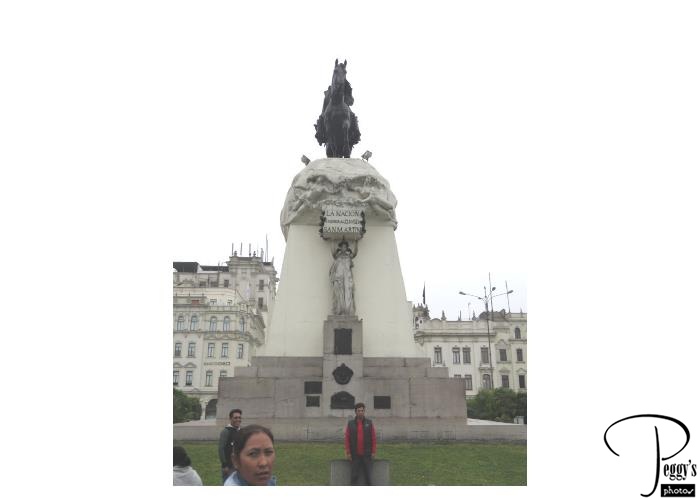
We went on a city tour of Lima’s Historic Center this morning with our tour manager and a local guide. Our first stop was at the Plaza San Martin where I was yesterday on another tour. Photo: Monument of San Martin, the liberator of Peru.
Church la Merced
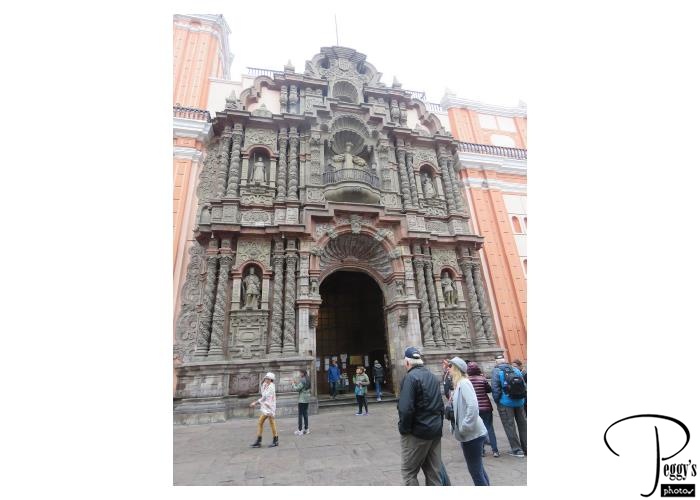
Our next stop was at the Church la Merced built in the Spanish Baroque Churrigueresque style in 1535.
Zumba Sunday–MOVIE
Our next stop was at Plaza Mayor with all the beautiful Spanish buildings surrounding the plaza. However, a stage was set for zumba dancing and the plaza was anything but quiet and my tour group was not seeing the plaza as a quiet, very pretty place as I had seen it before on two other tours. I took a movie of the zumba dancers––my camera microphone didn’t pick all the loud music.
Youtube: https://youtu.be/O–rudIPhwtg
Basilica & Convent of San Francisco
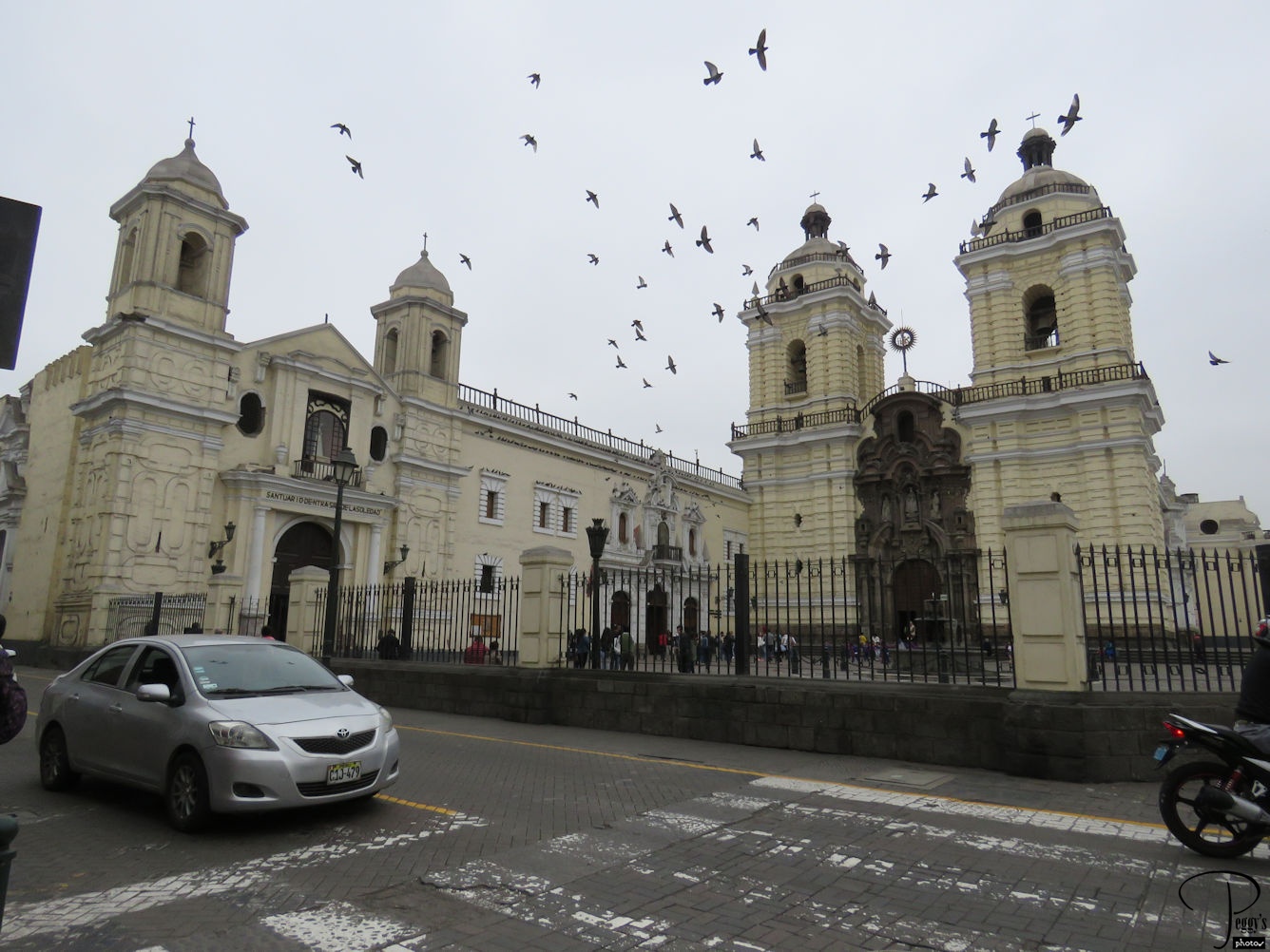
Our next and last stop was at the Basilica & Convent of San Francisco where I had been two days ago. My tour group went to take a tour of the convent, which I had already done, so I was going to sit in the lobby to wait for them when I heard music outside in the plaza. It was a Virgen del Carmen procession––see next entry.
Virgen del Carmen Procession–MOVIE
The Virgen del Carmen processions and festivals, many in Latin America and in Spain, are usually held on July 16, but this was near the end of August. I don’t know why it was held this day. The Virgen del Carmen refers to the Order of Our Lady of Mount Carmel, the Carmelites. In this procession, the costumes represent different periods of history and professions in Peru, though I couldn’t find explanations for many of them. The characters with the long noses either represent the Spanish or an unjust judge of the ruling class during the Republic. The characters in the white masks are the shepherds who travel with llamas and mules. Black masks represent freed African slaves. Gray masks represent the brutality inflicted on natives during the colonial era. The females represent different maidens. Seeing the procession was an unexpected treat. Again, my camera’s microphone didn’t pick up much of the music.
Youtube: https://youtu.be/ygilm_Pr7Uw
Basilica of San Francisco

We were given time to go inside the Basilica of San Francisco, which I had not done beforehand. This was the end of our city tour.
Lunch
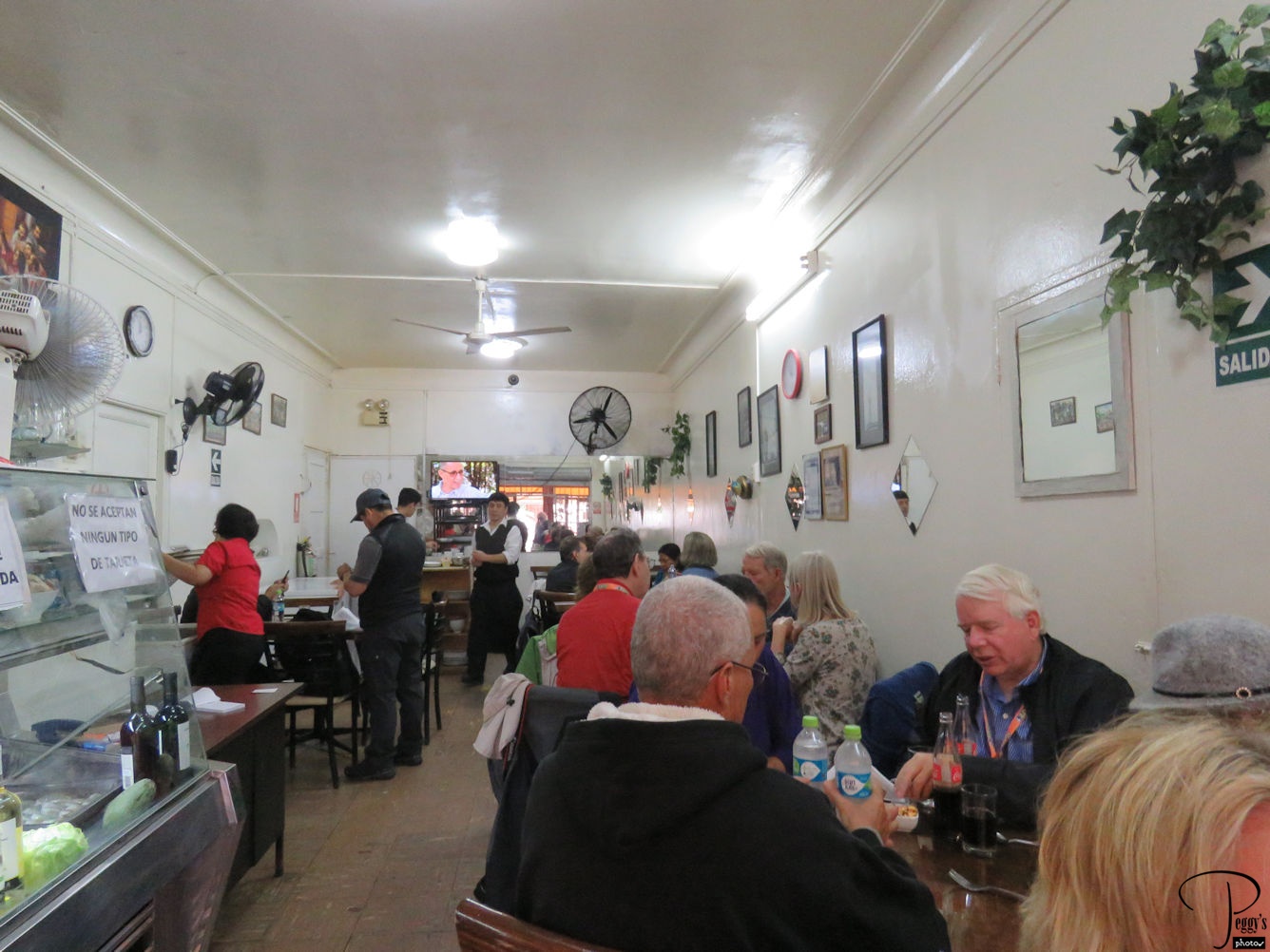
Julio suggested a restaurant near our hotel for lunch: a cevicheria, the Lobo de Mar Otani. I think most of my tour group ate here. Other than ceviche, the restaurant was known for its fried rice.
Lunch
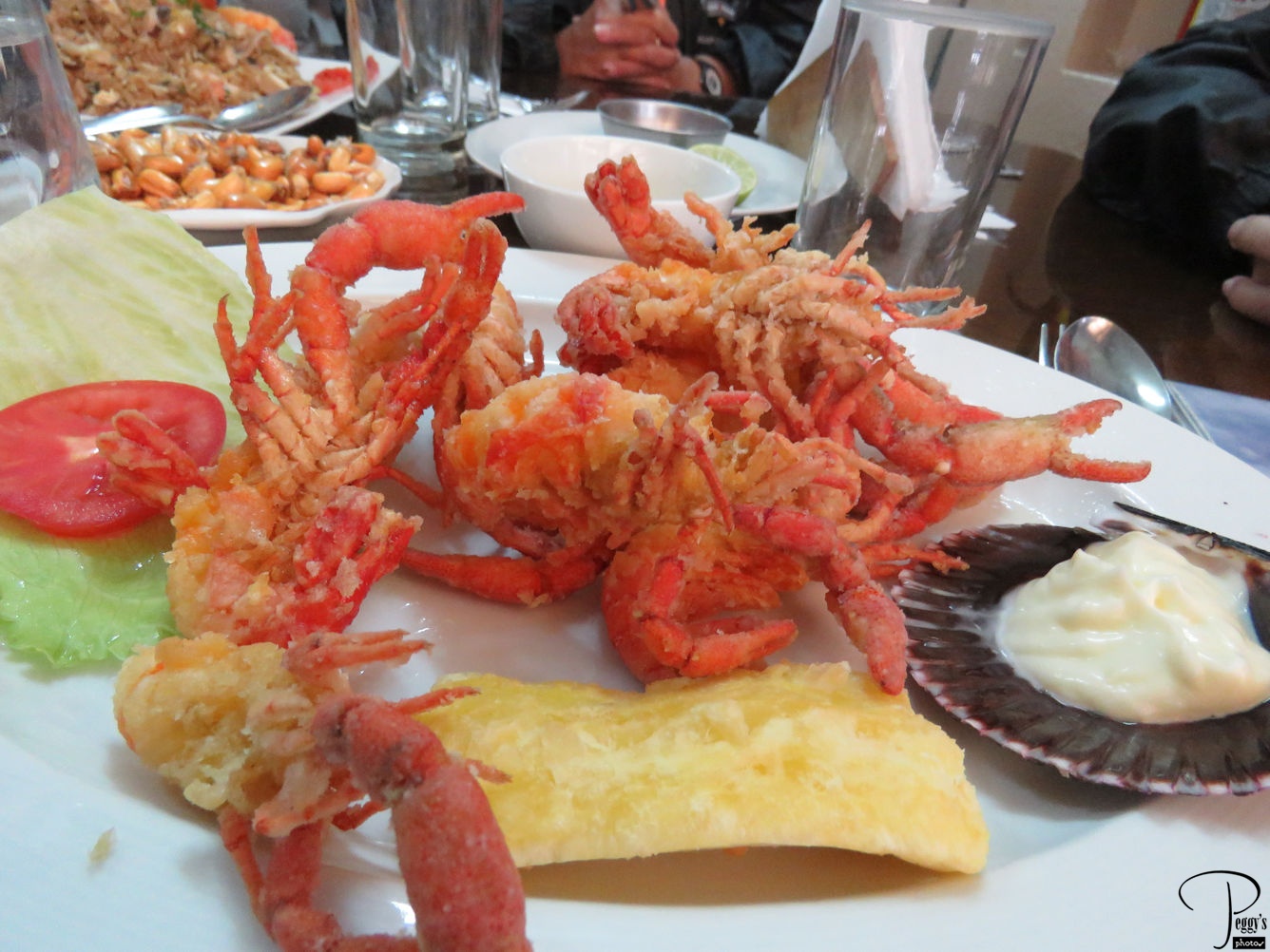
I had fried shrimp, served a bit differently than usual. An absolutely delicious lime dipping sauce was served with and it was the best fried shrimp that I have ever had.
Afternoon Tour
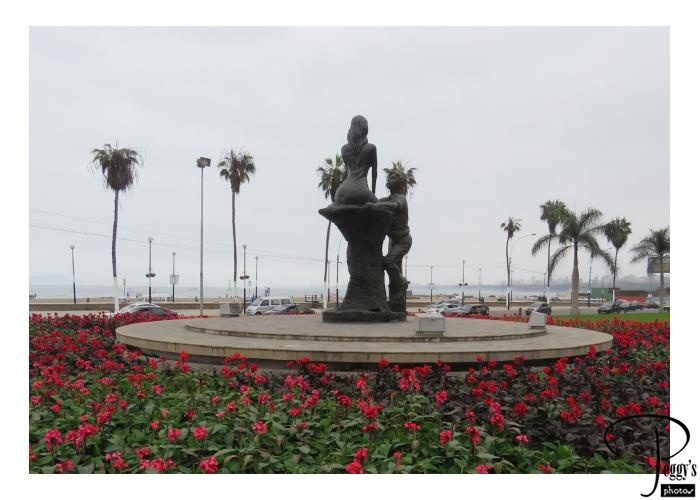
An afternoon optional tour was offered to the Pachacamaca pre–Inca and Inca ruins outside Lima. I went on the tour. We passed the romantic statue in a Chorrillos park on the way to Pachacamaca. This time when we passed it the statue was overlooking the Bay of Lima.
Amusement Park
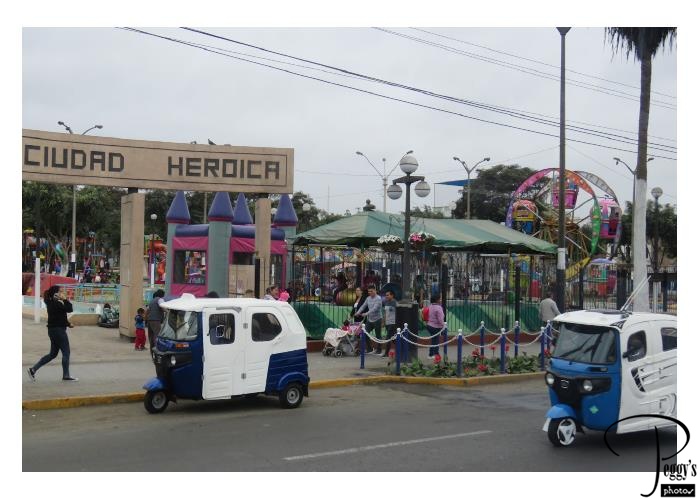
We also passed this large children’s amusement park. We saw many of these on our trip around Peru.
Modern Lima
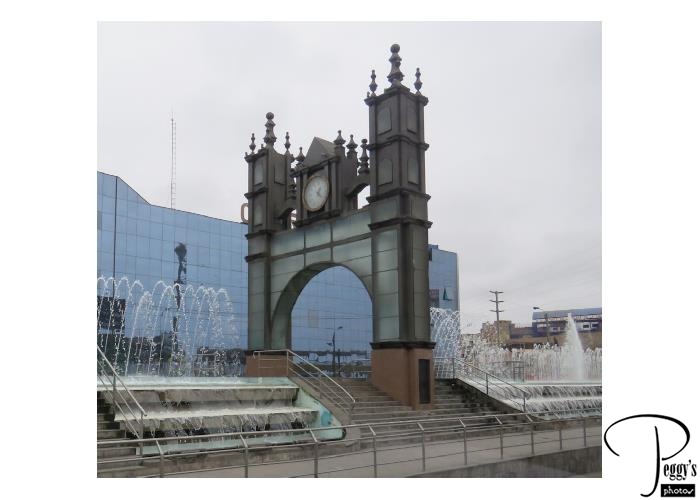
Then we drove past modern Lima.
Houses on a Hill
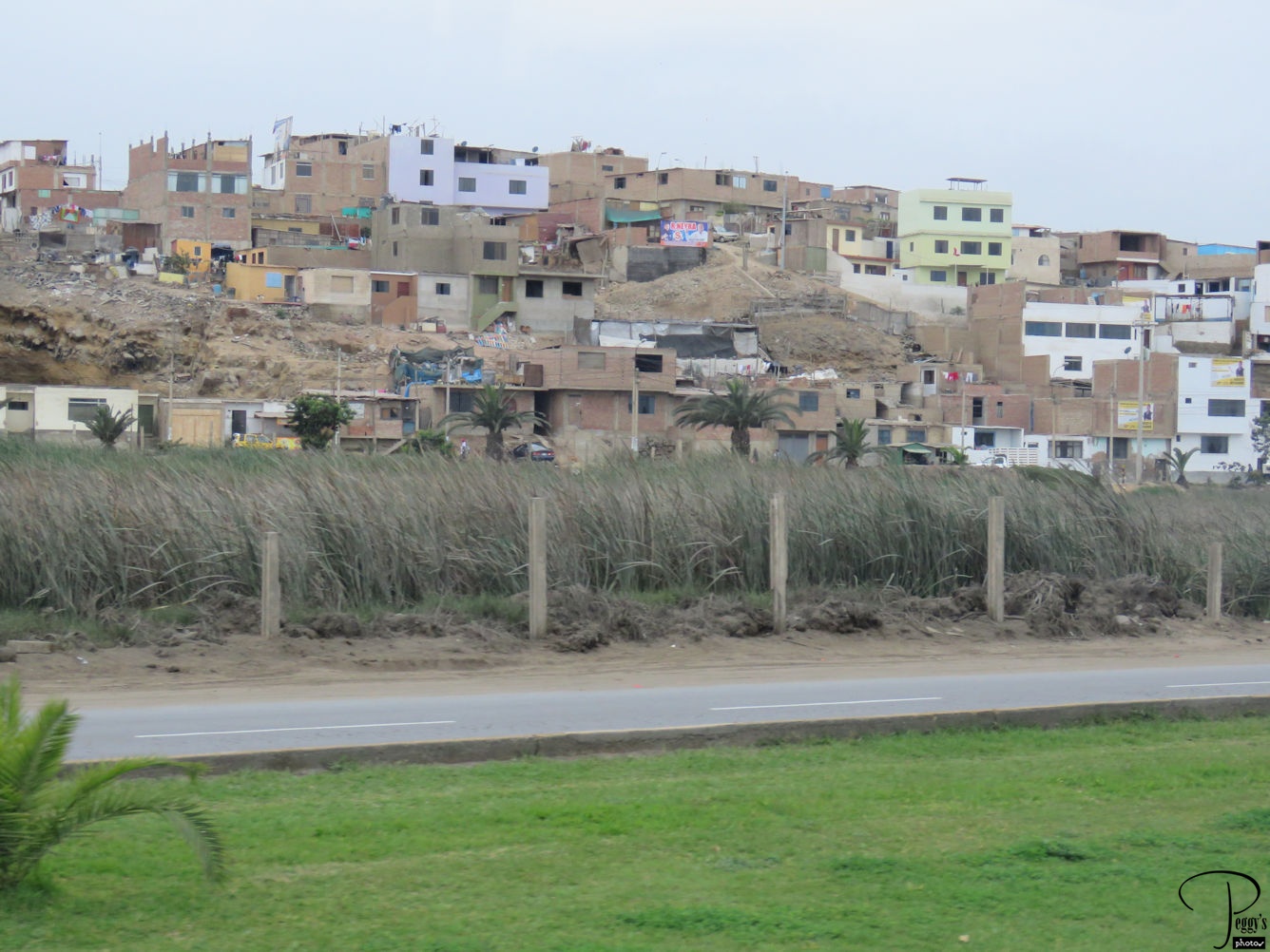
We also passed these houses on a hill, mostly showing a non–modern Lima.
Shantytown
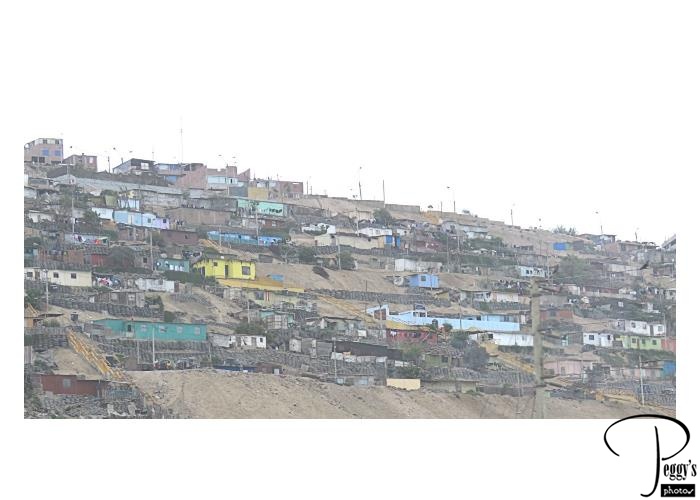
We also passed this shantytown.
Pachacamac
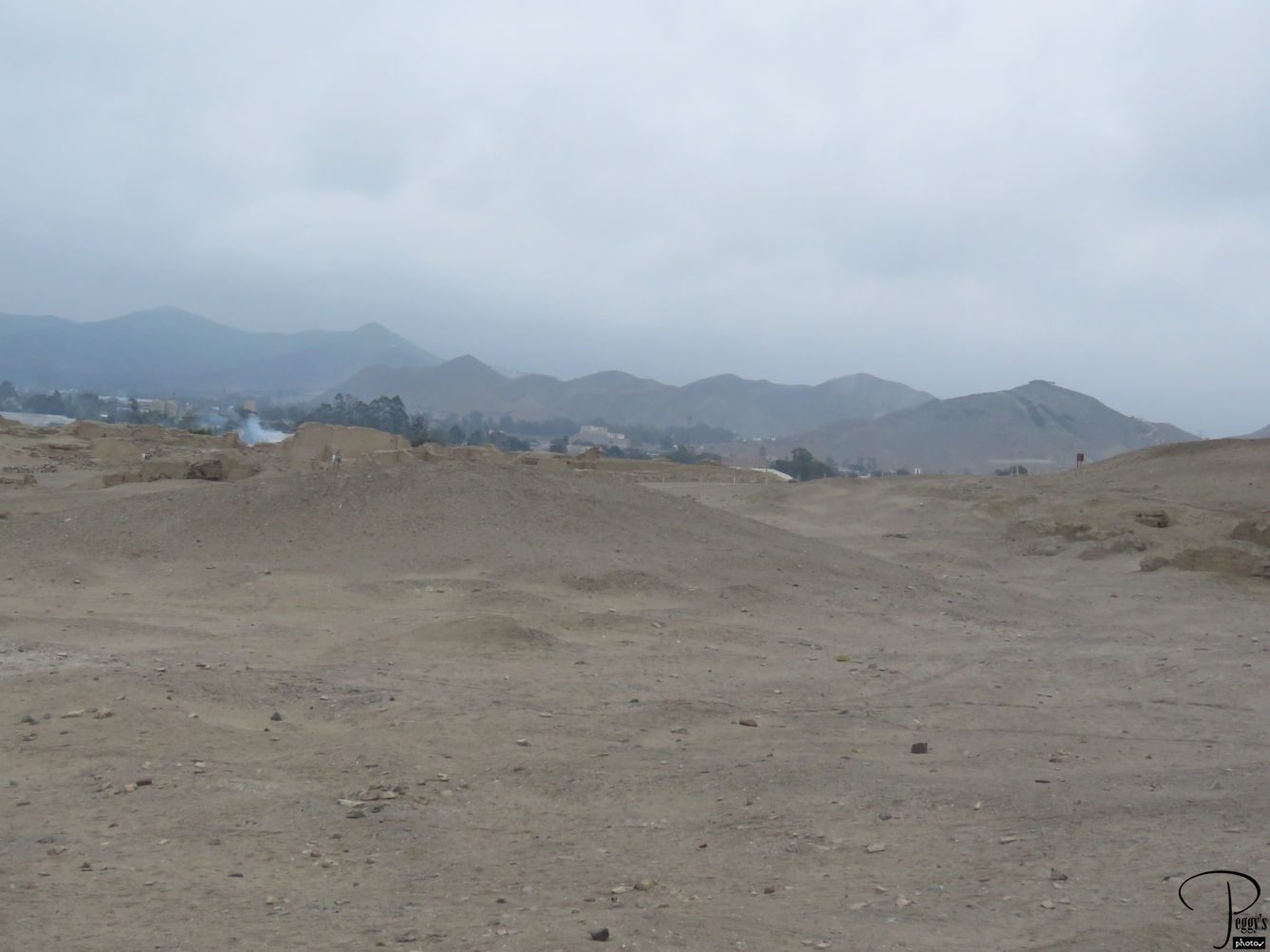
We are now in Pachacamac, 25 miles (40 km) southeast of Lima in the Valley of the Lurin River. Pachacamac covers about 1,483 acres (600 hectares). It was first settled around 200 AD and was named after Pacha Kamaq, the “Earth Maker” creator god. It was the seat of the Oracle Pachacamac and a place of pilgrimage from other cultures such as the Wari and Nazca.
Pachacamac

The site lasted for about 1,300 years. The Incas took it over in the late 1400s and the Spanish invaders destroyed much of it as well as did looters and weather. Some of the ruins are in better shape than are others and some have been restored. Photo: a pyramid with a ramp. Some of the pyramids here were sacred and for religious purposes and others were secular.
Pachacamac
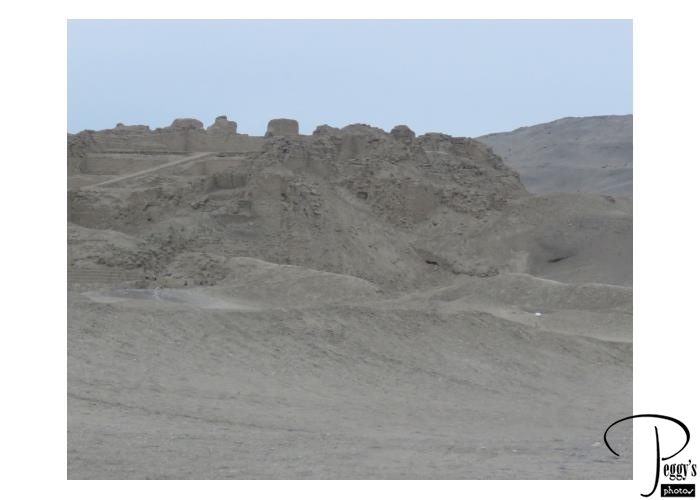
Another of the ruins.
Pachacamac
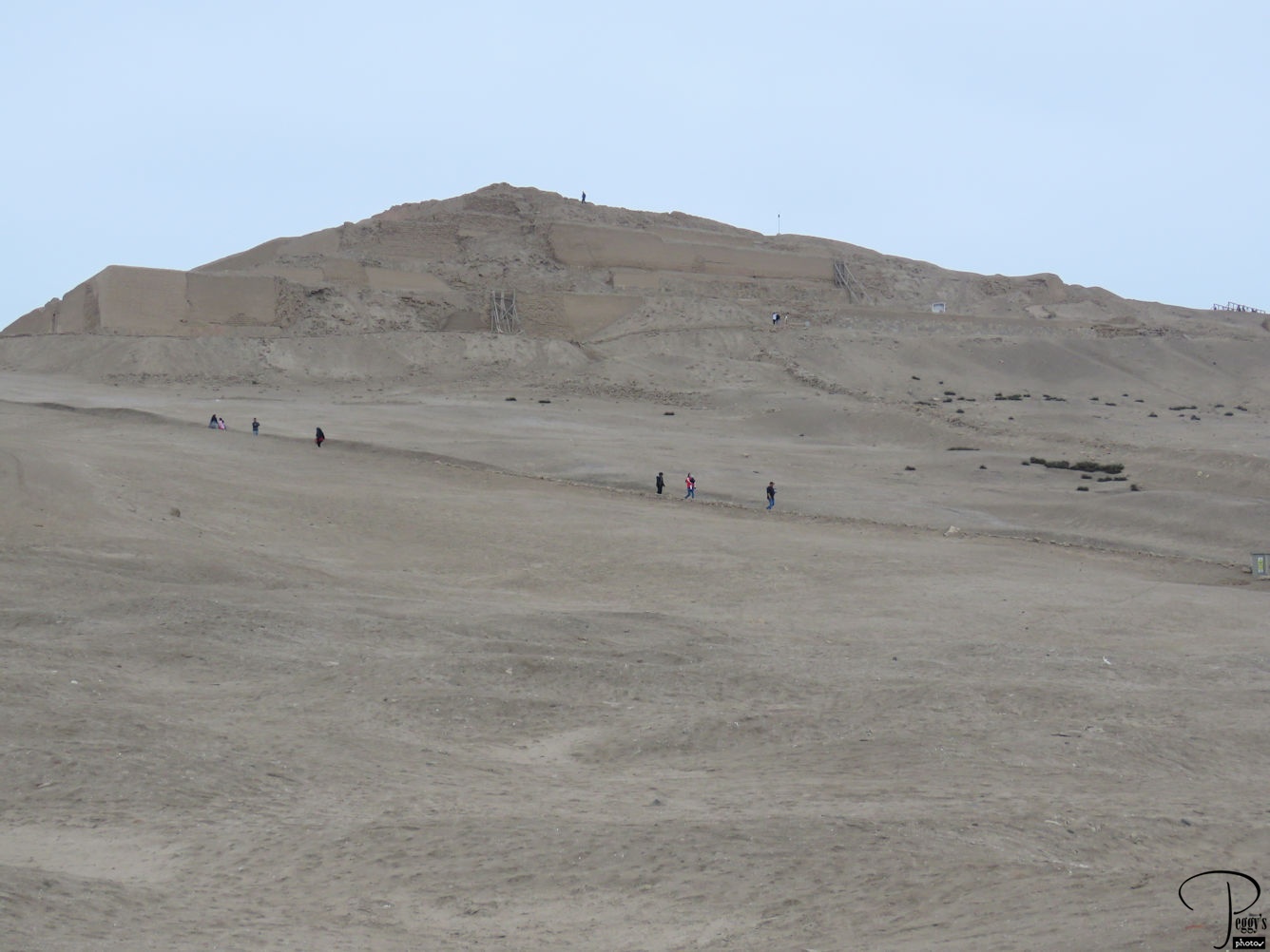
My tour group is in the photo walking up to the Temple of the Sun. I was far behind, walking very slowly with a sore foot.
Temple of the Sun
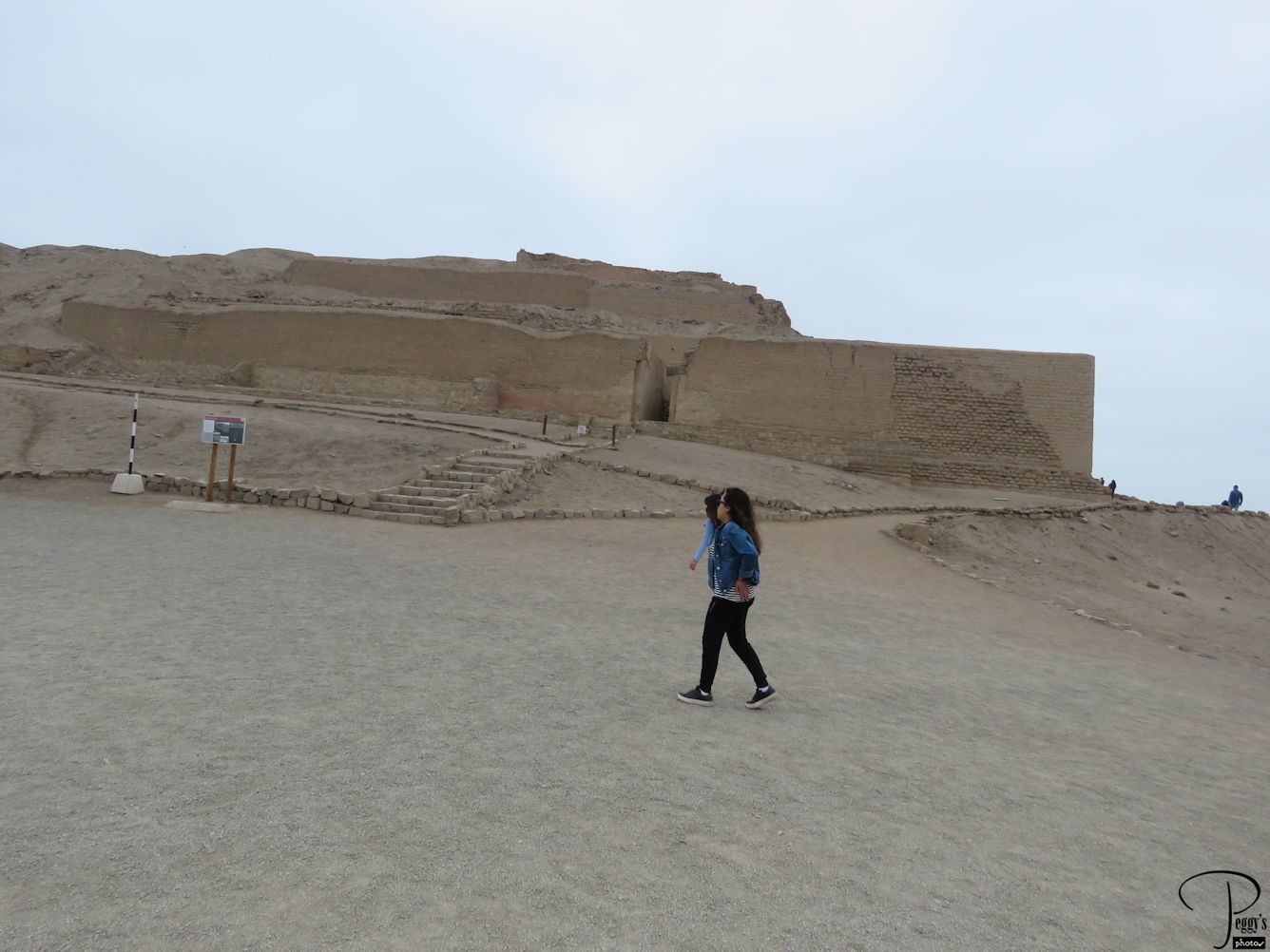
On top of the hill, at the Temple of the Sun. It is believed that the Incas built the Temple of the Sun and housed a wooden statue of Pachacamac in it. The Spanish are said to have destroyed the statue.
Mamacones Enclosure
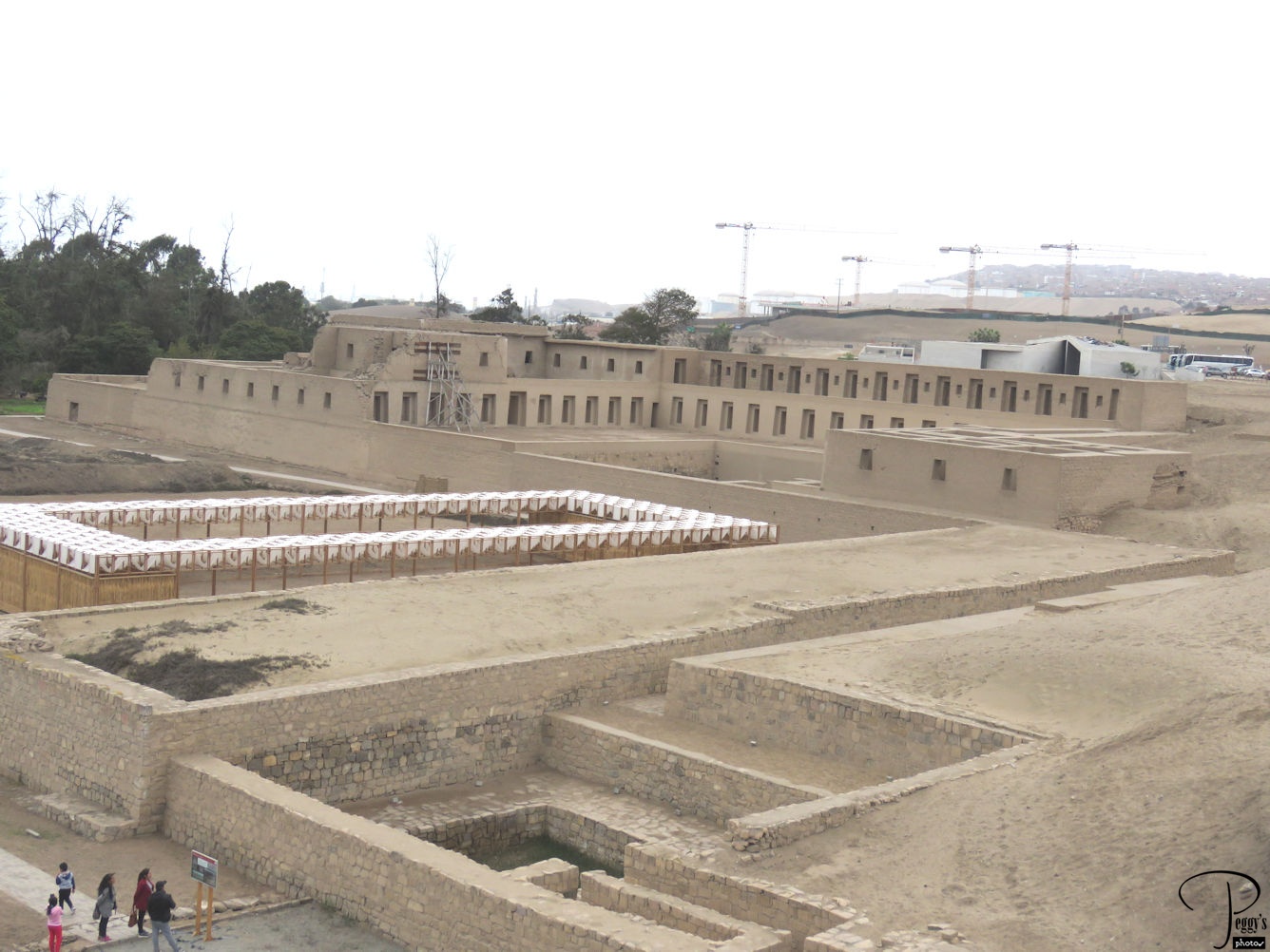
The Mamacones Enclosure, which was the nunnery, has been reconstructed. There is also a museum at Pachacamas though we didn’t visit it.
Julio
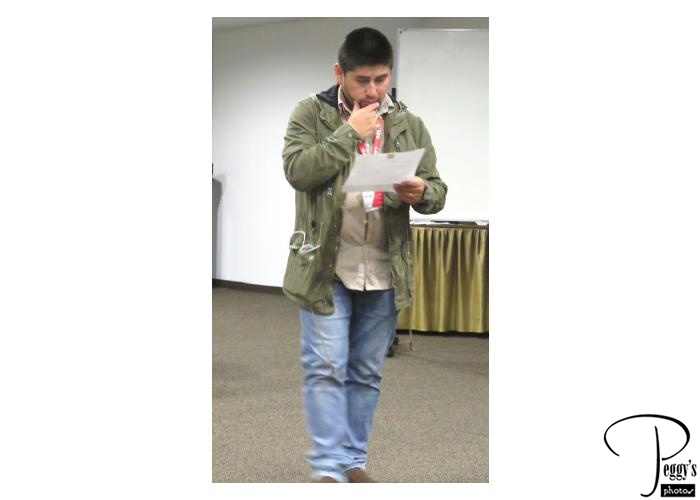
Early evening we had a tour meeting where we introduced ourselves and learned more about our tour. Our tour manager, Julio, in this photo, looks very pensive.
Larco Museum
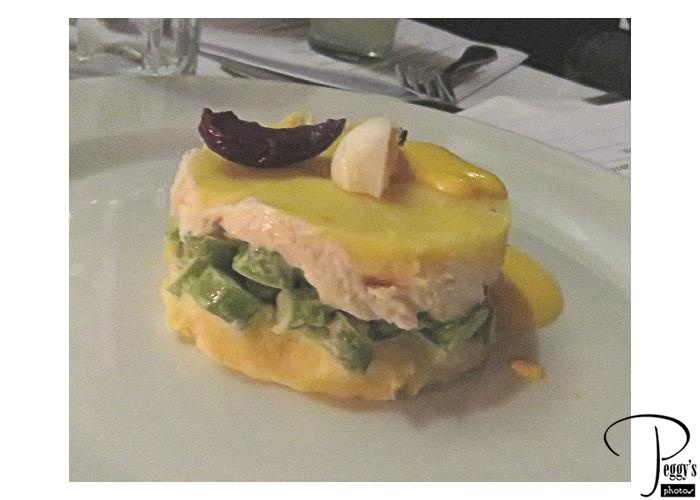
This evening we had another optional tour which I went on––dinner and a visit to the Larco Herrera Museum in Lima. Photo: one of the creative dishes in my dinner.
Larco Museum
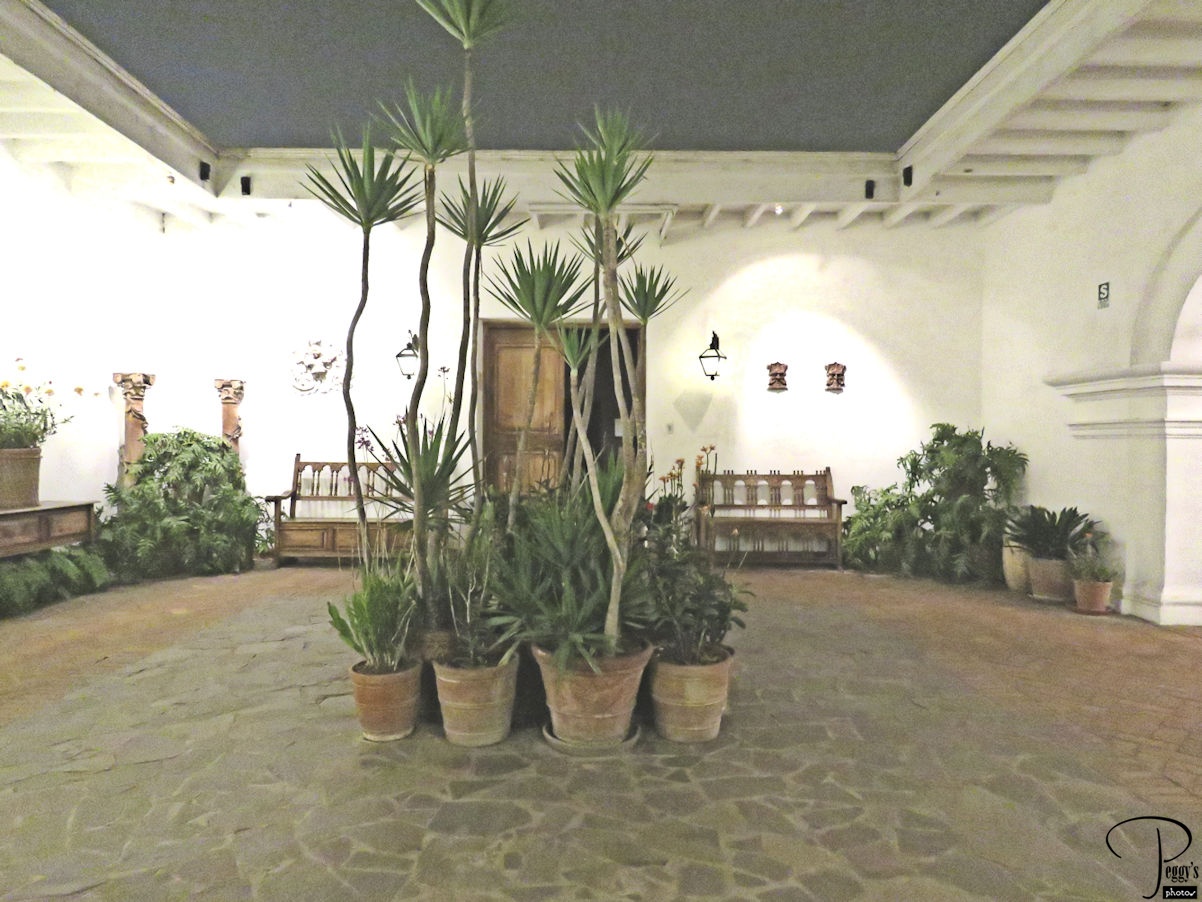
The Larco Herrera Museum in Lima is housed in an 18th–century building. It is privately owned and has the world’s largest collection of pre–Columbian artifacts, giving an overview of 4,000 years of Peruvian pre–Columbian history.
Larco Museum
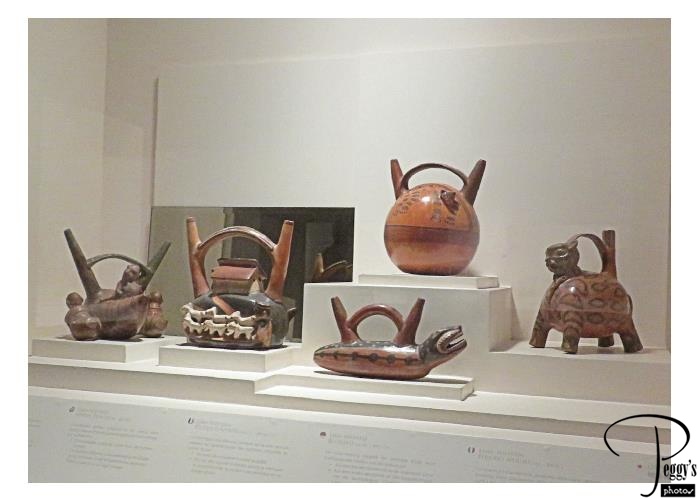
There is one room devoted to erotic sculptures in the museum and other rooms of pottery, sculptures, and other artifacts.
Larco Museum

In one room there were numerous shelves holding numerous masks, pottery, and sculptures.
Larco Museum
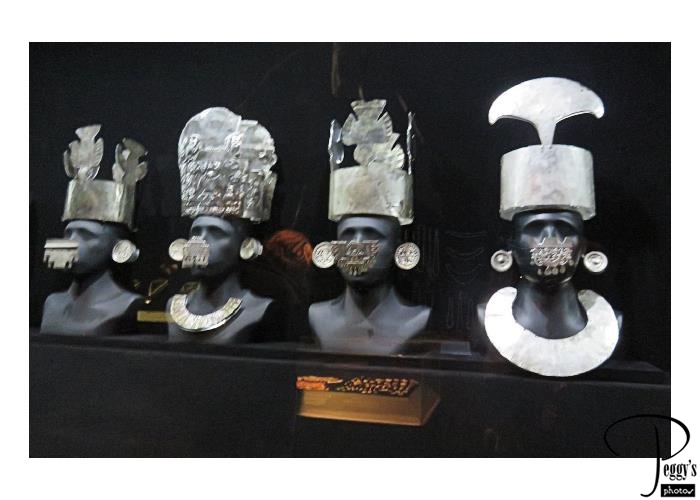
There were a number of ancient headdresses.
Larco Museum
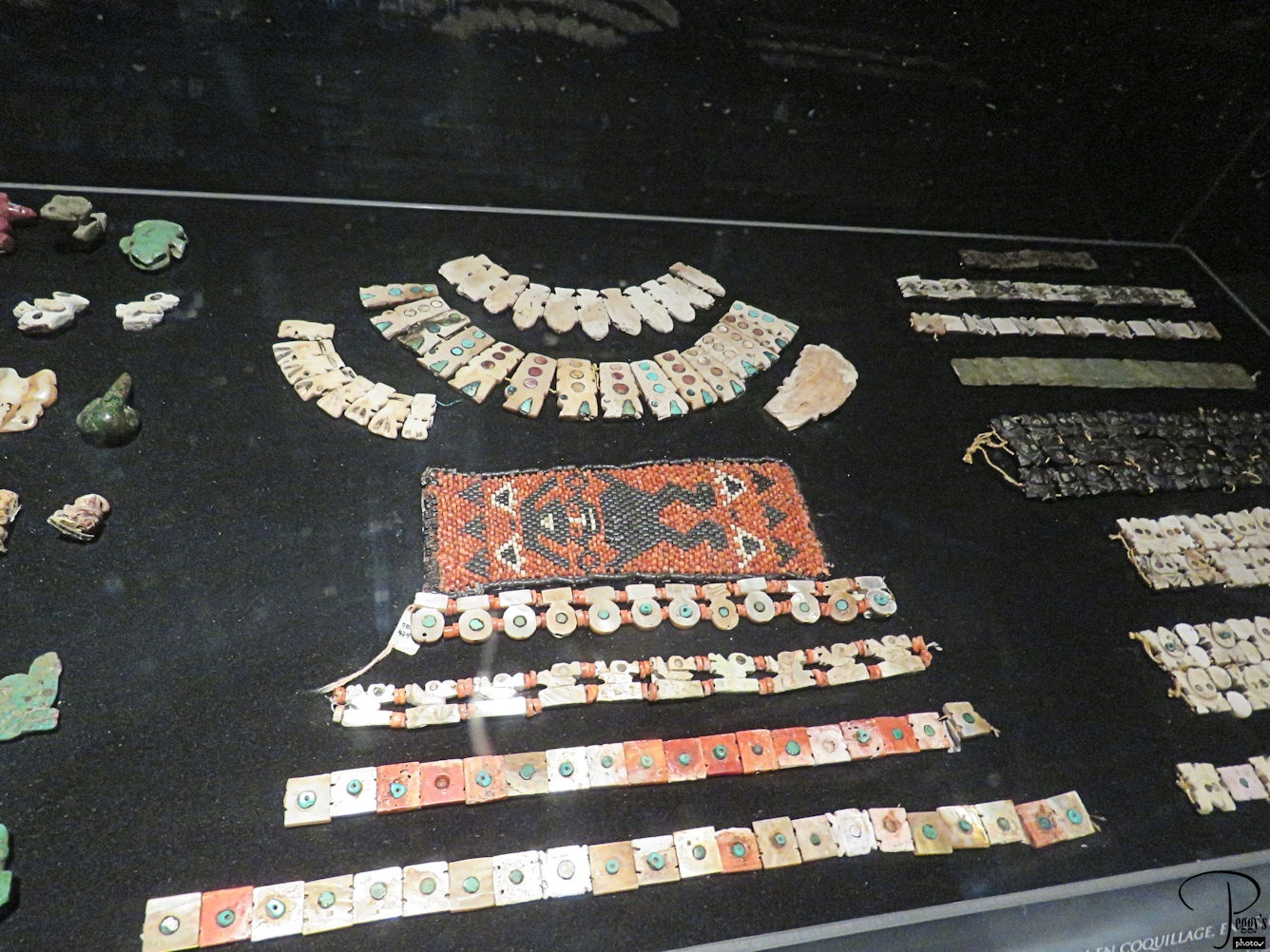
And also ancient jewelry.
I have put my photos of our Lima city tour, our trip to Pachacamac, and our visit to the Larco Museum on a slideshow. Go to http://www.peggysphotos.com/city–tour–pachacamac–larco–museum/ (Slide Shows, South America, Peru, Lima, “City Tour/Pachacamac/Larco Museum”).